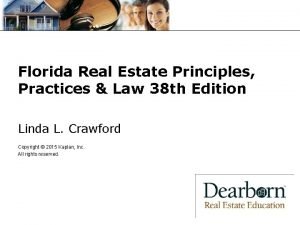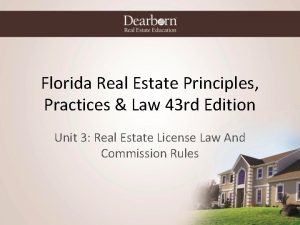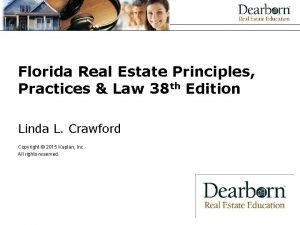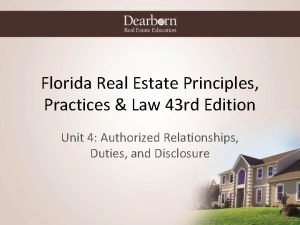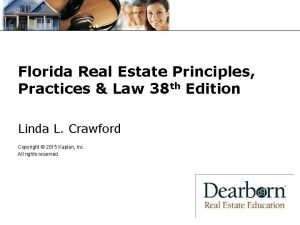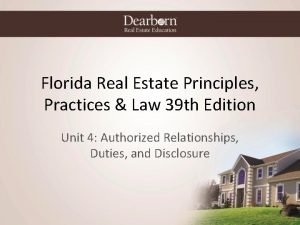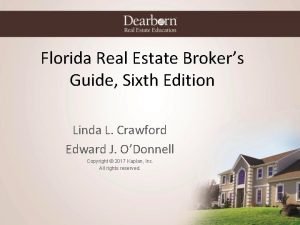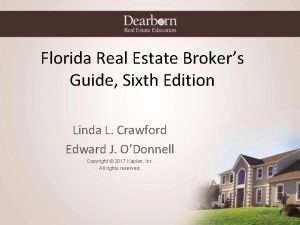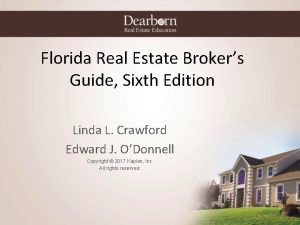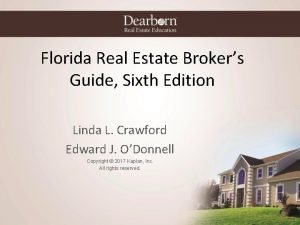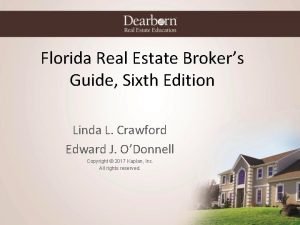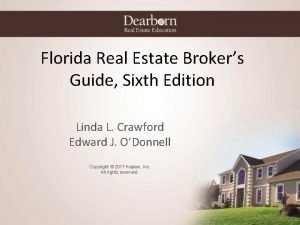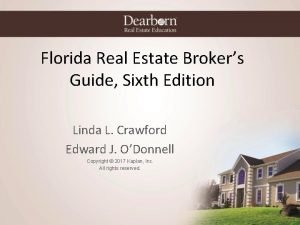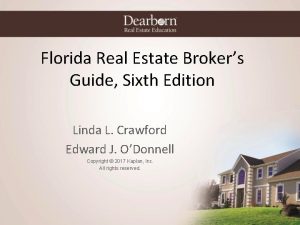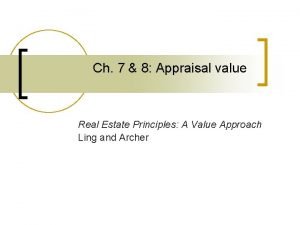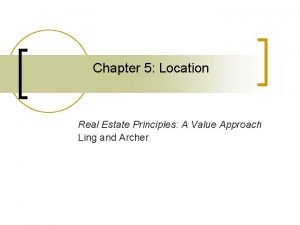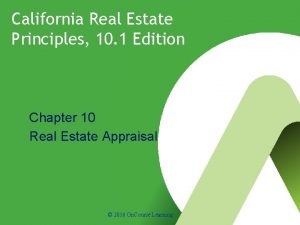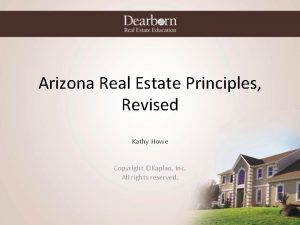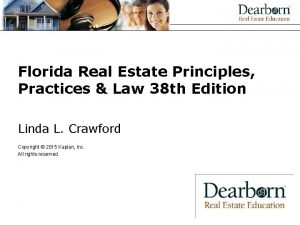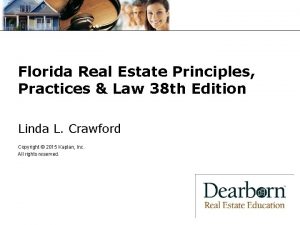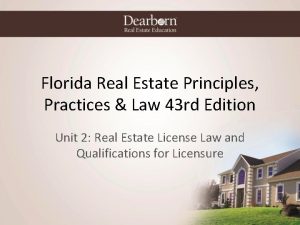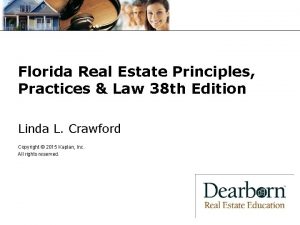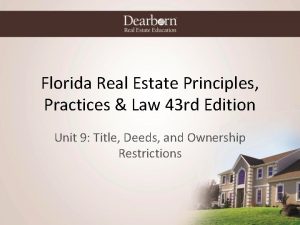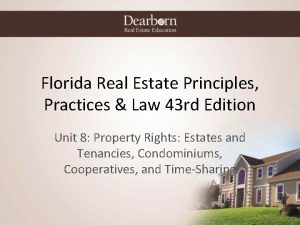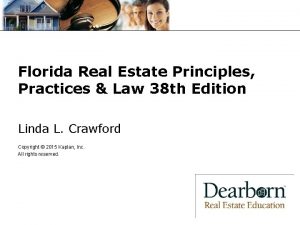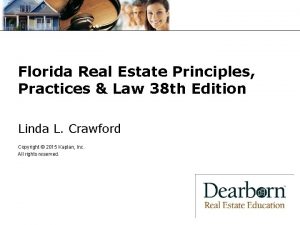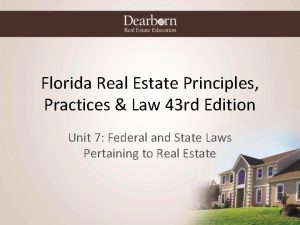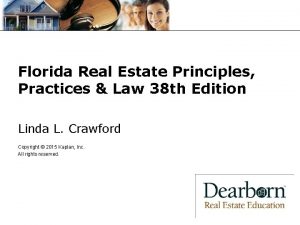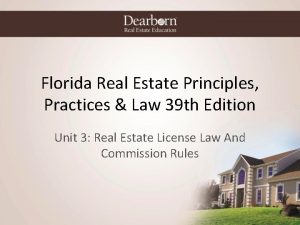Florida Real Estate Principles Practices Law 38 th























- Slides: 23

Florida Real Estate Principles, Practices & Law 38 th Edition Linda L. Crawford Copyright © 2015 Kaplan, Inc. All rights reserved.

Chapter 10 Legal Descriptions

Purposes of Legal Descriptions • Used to describe property in a way that uniquely identifies it from any other parcel • Survey is a drawing of a parcel showing its boundary lines and includes the legal description © 2015 Kaplan, Inc.

Types of Legal Descriptions • Metes-and-bounds • Government survey system • Lot and block description © 2015 Kaplan, Inc.

Description by Metes-and-Bounds – Metes refers to distance – Bounds refers to direction – Point of beginning (POB) • Exact starting point • Starting at POB, first boundary is determined from the legal description that indicates the direction and the distance to the first corner of parcel, and so on • Corners of the parcel are identified with a visible marker called a monument © 2015 Kaplan, Inc.

Metes-and-Bounds • Begin with either north or south followed by a number of degrees, up to 90 degrees • Direction that follows number of degrees indicates whether direction is east or west of due north or south; N 25°W • Directions are given in degrees, minutes, and seconds © 2015 Kaplan, Inc.

Metes-and-Bounds Directions N N 45⁰E W E S 60⁰W S © 2015 Kaplan, Inc.

Description by Government Survey • • US System of Rectangular Surveys Based on grid system Used in Florida but not the original 13 states Beginning reference is intersection of north/south line principal meridian and east/west line base line • 36 Principal meridians and base lines • Tallahassee Principal Meridian and Base Line © 2015 Kaplan, Inc.

Range • Vertical (north/south) range lines parallel to the principal meridian (PM) – Every six miles – Resulting six-mile-wide vertical (north/south) strip called range – Numbered beginning at PM – First vertical strip east of PM is Range 1 East (R 1 E); first strip west of PM is Range 1 West (R 1 W) – Range numbers increase by moving further from PM © 2015 Kaplan, Inc.

Township (tier) • Horizontal (east/west) township lines every six miles parallel to the base line (BL) – Series of lines six miles apart on either side of BL – Six-mile-wide horizontal east-west strip called tier or township – Numbered beginning at BL – First strip north of BL is Township 1 North (T 1 N); first strip south of BL is Township 1 South (T 1 S) – Township numbers increase moving further from BL © 2015 Kaplan, Inc.

Townships • Grid pattern formed by intersection of range lines and township lines Series of squares six miles square called townships • Township contains 36 square miles (6 miles on each side) • Identified by the township tier and range • T 2 S, R 3 E is located in second tier of townships south of base line and third range east of principal meridian • © 2015 Kaplan, Inc.

Principal Meridian, Baseline, Townships © 2015 Kaplan, Inc.

Sections • Each township contains 36 sections – Section is one square mile or 640 acres – Numbered in an S-pattern beginning in NE (upper right) corner with section 1 – Section, township and range • Section 36, T 1 S, R 1 W – Locating sections – Subdividing sections © 2015 Kaplan, Inc.

Sections © 2015 Kaplan, Inc.

Measures and Terms • Check Square 24 miles on each side created by intersecting guide meridians and correction lines • Township Square 6 miles on each side containing 36 square miles (36 sections); also east-west strip of land north and south of a base line • Section Square 1 mile on each side (1 mile square) containing 1 square mile (640 acres) © 2015 Kaplan, Inc.

Measures and Terms Government lot Fractional pieces of land (less than a full quarter section) located along the banks of lakes and streams Quarter section = 160 acres © 2015 Kaplan, Inc.

Calculating Size To find the number Example: of acres in a tract take 640 (acres in SW¼, NE¼, SE¼, NW¼ one section) and of Section 12, T 3 S, R 4 E divide by the denominator of each 640 ÷ 4 ÷ 4 = fraction in legal 2. 5 acres description © 2015 Kaplan, Inc.

And in a Legal Description If “and” is in middle of description calculate acres on either side of “and” separately then add to find total acres Example: SE¼ of the NW¼ of the NE¼ and N½ of the NW¼ of the NE¼ of Sec 21, T 4 N, R 5 W 640 ÷ 4 ÷ 4 = 10 640 ÷ 2 ÷ 4 = 20 10 + 20 = 30 acres © 2015 Kaplan, Inc.

Additional Survey Measures • Acre – 43, 560 square feet • Benchmark – Permanent reference mark affixed to an iron post or brass marker used to establish elevations • Mile – 5, 280 feet in length © 2015 Kaplan, Inc.

Example of Acreage • A lot measures 1/8 mile wide by ¼ mile deep. How many acres are in this lot? • Solution 5280 ÷ 8 = 660 feet 5280 ÷ 4 = 1320 feet 660 x 1320 = 871, 200 sq ft 871, 200 ÷ 43, 560 = 20 acres are in this lot © 2015 Kaplan, Inc.

Description by Lot and Block Numbers • Used only where plat maps have been recorded – Platted subdivision divided into large areas called blocks – Blocks divided into lots – Lots are numbered – Blocks are either numbered or lettered © 2015 Kaplan, Inc.

Plat Map l Engineer’s plan for land use on map of land l Provides for dedication of streets, parks, and school sites • Shows dimensions for lots, streets, planned improvements • Recorded under subdivision name by book and page number © 2015 Kaplan, Inc.

Tax Maps • Each parcel of land within a tax district is assessed for tax purposes – Each parcel is assigned a Parcel ID (PID) number by county property appraiser – PIDs used to prepare tax maps – Information used to prepare tax roll – PIDs sometimes used to identify a parcel © 2015 Kaplan, Inc.
 Florida real estate principles practices & law
Florida real estate principles practices & law Florida real estate principles practices & law 43rd edition
Florida real estate principles practices & law 43rd edition Ostensible partnership real estate
Ostensible partnership real estate Florida real estate principles practices & law 43rd edition
Florida real estate principles practices & law 43rd edition Florida real estate principles practices & law
Florida real estate principles practices & law Florida real estate principles practices
Florida real estate principles practices Florida real estate broker's guide
Florida real estate broker's guide Florida real estate broker's guide
Florida real estate broker's guide Florida real estate broker's guide 6th edition
Florida real estate broker's guide 6th edition Florida real estate broker's guide 6th edition
Florida real estate broker's guide 6th edition Florida real estate broker's guide 6th edition
Florida real estate broker's guide 6th edition Florida real estate broker's guide 6th edition
Florida real estate broker's guide 6th edition Florida real estate broker's guide
Florida real estate broker's guide Florida real estate broker's guide 6th edition
Florida real estate broker's guide 6th edition Florida real estate broker's guide 6th edition
Florida real estate broker's guide 6th edition Southpoint village apartments fishers indiana
Southpoint village apartments fishers indiana Income approach appraisal
Income approach appraisal Rent real estate principles a value approach
Rent real estate principles a value approach Rent real estate principles a value approach
Rent real estate principles a value approach Manoj chatlani
Manoj chatlani Arizona real estate law book
Arizona real estate law book Crm software for real estate law
Crm software for real estate law Newton's first law and second law and third law
Newton's first law and second law and third law Si unit of newton's first law
Si unit of newton's first law
